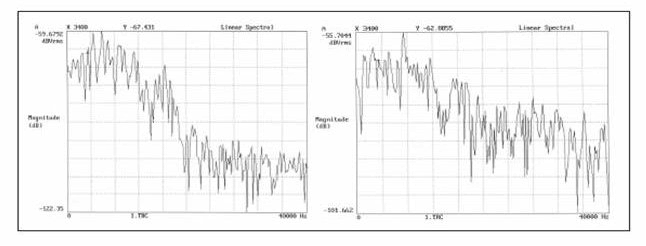Hobis inverkan på vilda djur
Älgforskarna känner även till ljudet, som har en ivägskrämmande effekt. Redan begreppet ”skrämmare” låter avskräckande! Ett skrämt vilt djur springer i panik vart som helst, i värsta fall in i trafiken. Meningen med Hobi är att få djuret att lyssna och i bästa fall gå tillbaka i egna spår. Enligt tester stannar vilda djur upp med pågående aktivitet och vänder örona eller hela huvudet mot ljudkällan.
Teknisk undersökning av Hobi
I november 2004 testade Joensuu universitet Hobi Ultrasonic Animal Alert.
Meningen med testerna var att klargöra vilka ljudfrekvenser Hobi skapade, i vilken hastighet den säder ut dessa frekvenser samt om den fungerar i praktiken. Hobis ljudspektrum och ljudnivå mättes både med tvingad luftström samt fri strömande luft och i verkliga situationer.
Tvingad luftström
Hobi monterades lufttätt i änden på ett rör, så att all luft som kom genom röret strömmade genom Hobi. Efter det monterades ett tryckluftsmunstycke i andra änden av röret och på så sätt fick man luften att strömma genom röret och Hobi. Genom att reglera tryckluftsmunstycket fick man till stånd olika nivåer av luftströmmar.
Fri luftström
Hobi monterades c:a 90 mm från tryckluftsmunstycket, varvid luftdushen kunde spridas så att delar av luften strömmade förbi Hobi. Med munstycket kunde man reglera luftströmmens mängd. Mätningarna genomfördes på samma sätt som vid mätningarna med tvingad luftström.
Mätningar i verklig situation
Hobi monterades på utsidan av bilens fönster, och man körde i olika farter. I farterna 70 km/h – 100 km/h var frekvenskurvernas magnituder relativt höga. Det visar oss, att när man kör i dessa farter kommer det ljud från Hobi.
Resultaten
I de ovan nämnda mätningarna har man kunnat konstatera att Hobi pruducerar ljud, när tryckskillnaden mellan dess luftintagsöppning och omgivningen är tillräckligt stor. Hobi fungerar när man kör inom de hastighetsbegränsningar som finns i Finland.
”We only determined that the drivers in question did not encounter wildlife and game. This includes roads that are normally crossed by wildlife or game. We assume that this can be attributed to the presence of the warning device”
- January 21 1980
- Veterinaerrat Dr. Josef Koenig,
- President,
- League Against Animal Torture and Abuse of Animal Testing,
- Vienna, Austria
- Veterinaerrat Dr. Josef Koenig,
“ We tested the device on horses to see if the sound would startle them and the test proved quite conclusively that it does not have any negative effect on horses”.
-
December 27 1984T.I. HughesExecutive Vice-PresidentOntario Humane Society,Newmarket, Ontario
“Inaudible frequencies in the range of 16-19 Khz were detected from A, “A” being the Holbie Model (Hobie Model). The speed at which inaudible frequencies were generated was approximately 35 miles-per-hour”.
-
June 8 1988James E. Morin,Calibration Lab Manager,TRANS-BAY ELECTRONICS, INCRicmond, California
HOBI UPDATE
2004 Study

“Figure 2.8 shows the pressure differences caused by various speeds proportioned to the measuments taken for free flow…..The figure also shows that the frequency curve magnitudes are relatively high between the speeds of 70 km/h and 100km/h when comparing them to the maximum magnitude of the curves. This proves that the whistle does make a sound when driving at these speeds.”
“Figure 2.8 shows that the spikes begin to be high enough to be properly heard at 80km/h -100km/h"
Study of Wildlife Alert Whistle
Harri PaatialaMaster’s Thesis Laboratory Study
November 2004
Department of Physics
University of Joensuu
Figure 2.5: Voice spectrums measured for free flow. The figures on the left shows
the voice spectrum when ΔP = 0.0042bar and on the right when ΔP>0.0317bar.The hearing range for moose, deer and other wild animals range from a few hertz to
over 20,000 hertz. As seen in diagram 2.5 Hobi emits sound at least up to 40,000 Hz
(measured between 50 – 40,000 Hz)According to Professor R. Silvennoinen, Ph. D., with Joensuu University in Finland,
the Hobi Ultrasonic Animal Alert works. He explains the test in the following
manner: When a vehicle is travelling at a speed of 100 km/h. one Hobi produces a
sound of 102 decibels In the same situation a pair of Hobi produce 105 – 106 dB.
Volume at 50m is 68,7dB and at 100m still at 40 dB -
2005 Study
“In my opinion, the tests show that the wild ruminants occuring in Finland in large numbers are able to hear the sound caused by the whistles tens of meters away and react to the sound in the same way as to any other stimuli deviating from their normal sound enviroment”
-
January 31 2005Kaarlo Nygrén,Researcher,Ilomantsi Game Research Station,Ilomantsi, Finland